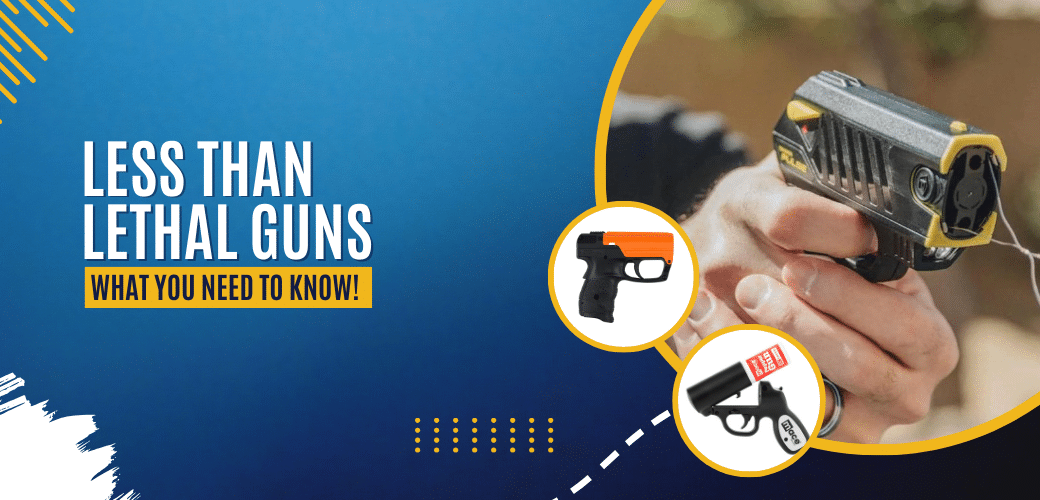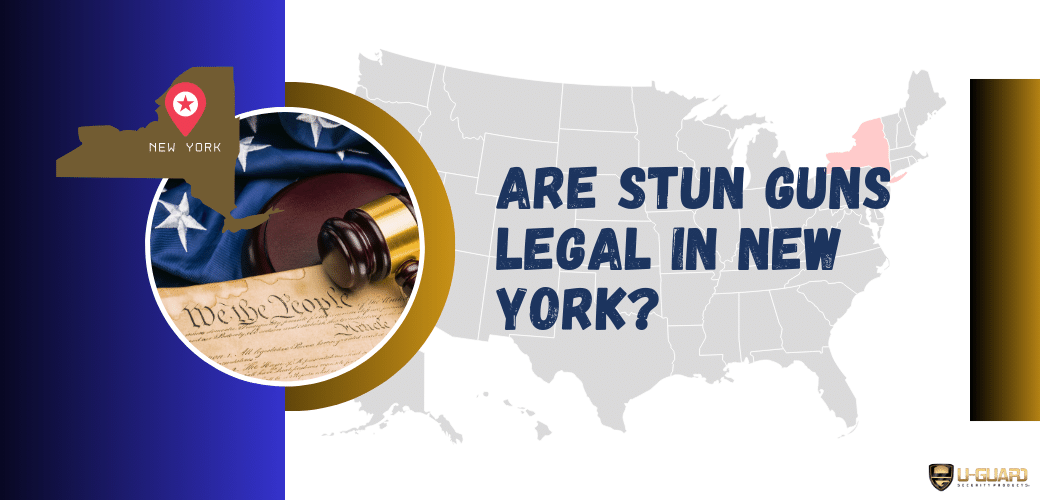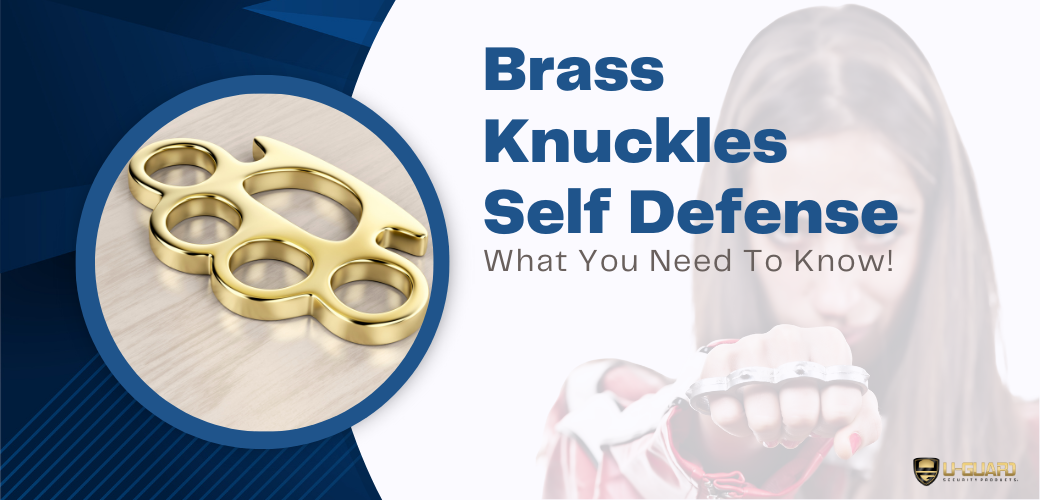Less than lethal guns, also known as less lethal guns, are a popular choice for individuals looking to protect themselves without resorting to deadly force. These weapons offer a non-lethal alternative to traditional firearms, such as handguns and rifles, and are often used in situations where lethal force is not warranted. In this blog post, we will explore the effectiveness of less than lethal guns, as well as alternative self-defense options and legal considerations to keep in mind when choosing a self-defense weapon.
Understanding Less Than Lethal Guns
Less than lethal guns represent a diverse category of self-defense tools specifically engineered to subdue or incapacitate an aggressor without inflicting permanent damage. Among these tools, stun guns and pepper sprays stand out for their widespread use and accessibility. Stun guns deliver a high-voltage, low-amperage electrical charge to disrupt muscle function and deter an assailant, whereas pepper spray causes intense irritation in the eyes, skin, and respiratory system, offering a window for escape or to seek help. Personal alarms, through emitting a loud sound, draw attention to a distressing situation, potentially scaring off an attacker or alerting nearby individuals. Expandable batons, while requiring closer proximity to an aggressor, provide a physical means to defend oneself without resorting to lethal measures. These devices are specifically designed with portability in mind, allowing for easy carry in various settings whether at home, in the office, or within personal vehicles. Their design and functionality underscore a commitment to safety and self-defense, prioritizing the de-escalation of potentially harmful situations without crossing the threshold into lethal force. This category’s inclusivity and adaptability make it an essential consideration for those seeking to bolster their personal security measures.
Alternatives to Less Than Lethal Guns for Self-Defense
For those seeking additional means of protection, numerous alternatives to less than lethal guns are available that cater to different needs and situations. Tasers, for instance, offer a ranged option, shooting probes at an attacker to deliver a debilitating electric shock from a safe distance, effectively incapacitating them momentarily. On the more traditional side, self-defense tools like tactical pens or personal safety alarms provide discreet yet effective ways to deter assailants. The tactical pen, a robust writing instrument, can be used as a stabbing tool in close encounters, while a personal safety alarm emits a loud sound to attract attention and potentially scare off attackers.
Innovative self-defense gadgets also include wearable technology like rings or bracelets designed to send emergency alerts or GPS locations to trusted contacts with a simple press. For individuals looking to empower themselves physically, self-defense classes such as Krav Maga, Brazilian Jiu-Jitsu, or even basic self-defense workshops can equip them with valuable skills and confidence to face potential threats. These classes not only teach physical techniques but also situational awareness and de-escalation tactics, providing a comprehensive approach to personal safety.
Exploring these alternatives allows individuals to find a self-defense solution that aligns with their comfort levels, lifestyle, and the specific risks they may face. Whether opting for physical training, discreet gadgets, or direct defense tools, the key lies in selecting a method that enhances one’s sense of security and preparedness.
Using less than lethal guns such as a Taser gun, pepper spray gun, bean bag gun, and or a pepper ball gun for self-defense can have numerous benefits. However, when deciding between a pepper gun and a pepper spray canister, it’s important to consider the advantages and disadvantages of each option.
The Mechanism and Efficacy of Pepper Guns
Pepper guns, artfully designed for precision and effectiveness, function by propelling a focused stream of oleoresin capsicum, commonly known as pepper spray, towards an aggressor. This innovative mechanism is engineered for simplicity, ensuring that individuals can swiftly and accurately deploy the device in moments of distress. The strategic advantage lies in their ability to maintain a safe distance between the user and potential threat, with the capacity to accurately hit targets up to 25 feet away. This feature is particularly advantageous in situations where proximity could escalate the risk of harm. The inherent design of these devices, mimicking that of a traditional handgun, not only facilitates ease of use but also enhances the user’s confidence through familiarity with the form. This sophisticated approach to personal defense underscores the blend of functionality and innovation, offering a reliable solution for those prioritizing safety while adhering to principles of non-lethal force.
Advantages of Choosing a Pepper Gun Over Pepper Spray
Opting for a pepper gun as a self-defense tool offers distinctive benefits over its counterpart, the pepper spray canister. Foremost among these is the enhanced control and precision afforded by the design of the pepper gun. Its ability to project a targeted stream of pepper spray with accuracy from a distance empowers individuals, granting them the ability to deter a potential threat from a safer vantage point. This strategic advantage is crucial in situations where maintaining distance is imperative for personal safety. Additionally, the ergonomic design and intuitive operation of pepper guns provide an ease of use that is particularly appealing to those who may be less familiar with self-defense tools. The design not only facilitates quick deployment in critical moments but also contributes to a higher capacity for pepper spray, allowing for several uses before necessitating a refill. This combination of range, accuracy, and user-friendly operation positions the pepper gun as a superior choice for individuals prioritizing both safety and efficiency in their self-defense strategy.
Potential Drawbacks and Considerations
Despite the notable benefits that pepper guns offer, there are a few considerations that warrant attention. The initial cost associated with acquiring a pepper gun might be higher than that of traditional pepper spray canisters. This investment reflects the advanced technology and enhanced features provided but may not be feasible for all budgets. Additionally, the physical dimensions and design of pepper guns might pose a challenge for discreet carry, potentially limiting their appeal for individuals seeking a more concealable self-defense option. It’s also crucial to remain mindful of legal restrictions and regulations surrounding the ownership and use of pepper guns, which can vary widely by jurisdiction. These factors collectively contribute to the decision-making process, underscoring the importance of a thoughtful evaluation based on personal needs and circumstances.
Understanding the Difference: Pepper Ball Guns vs. Pepper Spray Guns
Diving into the nuances between pepper ball guns and pepper spray guns reveals significant differences that cater to varied self-defense preferences. Pepper ball guns operate by launching spherical capsules filled with a powdered pepper agent. These projectiles, upon impact, burst to release the pepper substance, creating a cloud that can incapacitate multiple aggressors at once or block paths of entry. This method is notably distinct from the operation of pepper spray guns, which emit a direct stream or mist of liquid pepper solution. This allows for a concentrated effect on a single target, providing a more focused approach to neutralization.
Pepper ball guns, with their capability to cover wider areas and affect multiple threats, are particularly valued in scenarios requiring crowd control or when facing multiple assailants. On the other hand, pepper spray guns, with their precision and ease of aim, serve well in personal defense situations where avoiding collateral impact is crucial. The choice between the two extends beyond mere preference, reflecting a strategic decision based on anticipated defense scenarios. Understanding these differences is pivotal for anyone considering adopting these less than lethal alternatives, ensuring the selection aligns with their security needs and comfort level.
The Effectiveness of Less Than Lethal Weapons
The utility of less than lethal weapons in self-defense scenarios hinges on several variables including the user’s proficiency, environmental factors, and the assailant’s determination and physical condition. While these tools are engineered to incapacitate or deter an aggressor, their success rate is not absolute. Factors such as the user’s aim, the weapon’s range, and the assailant’s clothing or physical resistance can significantly affect outcomes. Additionally, environmental conditions like wind can influence the effectiveness of sprays, and barriers may obstruct the path of a stun gun’s prongs. Therefore, relying solely on these devices without understanding their limitations and without proper training can lead to overconfidence in precarious situations. Continuous practice and situational awareness training enhance one’s ability to deploy these weapons effectively, increasing the likelihood of successfully neutralizing a threat. It’s imperative for users to not only familiarize themselves with their chosen device but also to remain cognizant of the inherent unpredictability of self-defense situations.
Legal Considerations When Choosing Less Than Lethal Weapons
Navigating the legal landscape surrounding the ownership and usage of less than lethal weapons is a critical step for anyone considering these tools for self-defense. Regulations governing these devices vary significantly from one jurisdiction to another, often with nuanced differences that could affect their legality in specific scenarios or locations. For example, while stun guns might be perfectly legal for civilian use in one state, they could be heavily restricted or outright banned in another. Similarly, carrying pepper spray might require adherence to concentration limits or possession permits in certain areas.
To ensure compliance with local laws, prospective buyers should conduct thorough research or consult legal experts familiar with weapons regulations in their area. Understanding these legal nuances is crucial, as violations can lead to significant legal consequences, including fines or criminal charges. It’s also wise to stay informed about any changes in legislation that might affect the status of less than lethal weapons in your locality.
Moreover, it’s not just about possession but also the appropriate use of these weapons. There are legal frameworks outlining when and how force can be used in self-defense. Familiarizing oneself with these concepts is essential to not only safeguarding oneself from physical harm but also from potential legal repercussions resulting from the use of force in self-defense situations.
Factors to Consider Before Purchasing a Less Than Lethal Gun
When contemplating the acquisition of a less than lethal gun, it’s paramount to evaluate a variety of considerations that go beyond mere cost or aesthetic appeal. The effectiveness of the weapon in real-world scenarios is crucial; hence, one must assess its range, ease of use, and reliability under stress. Compatibility with your lifestyle and circumstances also plays a significant role. For instance, the size of the weapon should complement your daily attire or storage possibilities at home or in a vehicle, ensuring it is readily accessible when needed.
Another critical factor is the legal landscape of your location. Different states and municipalities have varied regulations concerning the possession and use of less than lethal weapons, which can influence your decision significantly. Understanding these legalities can prevent unintended violations that could lead to legal repercussions.
Lastly, consider the maintenance and longevity of the device. Like any tool, less than lethal guns require upkeep to ensure functionality at critical moments. Research the manufacturer’s recommendations for maintenance and assess whether you are willing to undertake this responsibility. Additionally, exploring customer reviews and product testing reports can provide insight into the weapon’s durability and operational lifespan, aiding in making an informed purchase decision that aligns with your self-defense strategy.
Training and Preparedness for Using Less Than Lethal Weapons
Achieving proficiency with less than lethal weapons transcends mere ownership. It necessitates a commitment to rigorous training and a deep understanding of the weapon’s capabilities and limitations. Engaging in regular practice sessions not only solidifies muscle memory but also boosts confidence in one’s ability to operate the weapon under stress. This could include drills that simulate real-life scenarios, enabling the user to respond swiftly and effectively when faced with a threat. Additionally, enrolling in self-defense courses that focus on the practical application of these weapons can provide invaluable insights into strategic positioning, timing, and the legal implications of their use in various situations. Equally important is familiarizing oneself with the weapon’s safety mechanisms to prevent accidental discharge or harm to oneself and others. In essence, the journey towards empowerment through less than lethal weapons is anchored in a comprehensive approach that blends physical preparedness with strategic acumen.
The Future of Less Than Lethal Weapons
The landscape of personal defense is poised for dynamic changes as innovations in less than lethal weapon technology gain momentum. Manufacturers are increasingly focusing on integrating smart technologies with self-defense tools to enhance their effectiveness and user safety. This includes the development of devices that can adapt their response based on the level of threat or that can be remotely activated, offering users greater control and versatility in unpredictable situations.
Emerging technologies such as non-lethal projectiles that can mark assailants with traceable dyes or biometrics for personalized weapon activation are also on the horizon. These advancements aim to reduce the risk of misuse and ensure that these tools are only used by their rightful owners. Furthermore, the integration of AI and machine learning could see less than lethal weapons becoming more autonomous, capable of assessing threats and responding appropriately without direct human intervention.
Research into materials science promises to bring about less than lethal weapons that are not only more compact and lightweight but also more reliable and durable. The potential for wearable technology that doubles as personal defense tools is being explored, blurring the lines between everyday accessories and lifesaving equipment.
As these technologies evolve, the dialogue around legal and ethical considerations will undoubtedly intensify. It will be paramount for legislation to keep pace with technological advancements, ensuring that the use of less than lethal weapons continues to be a viable and regulated option for personal safety. Staying informed about these developments is crucial for anyone interested in personal defense, as the future holds the promise of more sophisticated, effective, and accessible means of ensuring personal security.
Expert Device Support and Training Recommendations
Navigating the world of less than lethal guns, with their intricate functionalities and strategic applications, demands more than a cursory understanding. Acknowledging this, it becomes imperative to engage with expert support and specialized training. This ensures not only the adept handling of these sophisticated devices but also reinforces responsible usage. Many purveyors of pepper guns and pepper spray canisters extend comprehensive training programs designed to equip individuals with the knowledge and skills required for effective self-defense. Moreover, expert support teams are on standby, ready to assist with any operational queries or maintenance concerns. This blend of educational resources and readily available assistance empowers users, enhancing their confidence and proficiency in deploying these non-lethal defense tools safely and effectively.





